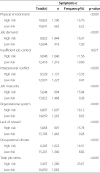BoguckiS. RabinowitzPM. . Occupational health of police and firefighters. Textbook of clinical occupational and environmental medicine. 2005. 2. Philadelphia: Elsevier Saunders Pub;p. 272–274.
SmithDL. ManningTS. PetruzzelloSJ. Effect of strenuous live-fire drills on cardiovascular and psychological responses of recruit firefighters. Ergonomics. 2001. 25(3):244–254. PMID:
11219758.
WagnerD. HeinrichsM. EhlertU. Prevalence of symptoms of posttraumatic stress disorder in German professional firefighters. Am J Psychiatry. 1998. 25(12):1727–1732. PMID:
9842783.
CorneilW. BeatonR. MurphyS. JohnsonC. PikeK. Exposure to traumatic incidents and prevalence of posttraumatic stress symptomatology in urban firefighters in two countries. J Occup Health Psychol. 1999. 25(2):131–141. PMID:
10212865.
TornlingG. GustavssonP. HogstedtC. Mortality and cancer incidence in Stockholm fire fighters. Am J Ind Med. 1994. 25(2):219–228. DOI:
10.1002/ajim.4700250208. PMID:
8147394.
LundbergU. Psychophysiology of work: stress, gender, endocrine response, and work-related upper extremity disorders. Am J Ind Med. 2002. 25(5):383–392. DOI:
10.1002/ajim.10038. PMID:
12071491.
IrieM. AsamiS. NagataS. MiyataM. KasaiH. Relationships between perceived workload, stress and oxidative DNA damage. Int Arch Occup Environ Health. 2001. 25(2):153–157. DOI:
10.1007/s004200000209. PMID:
11317710.
BosJ. MolE. VisserB. Frings-DresenM. Risk of health complaints and disabilities among Dutch firefighters. Int Arch Occup Environ Health. 2004. 25(6):373–382. PMID:
15338222.
SaijoY. UenoT. HashimotoY. Job stress and depressive symptoms among Japanese firefighters. Am J Ind Med. 2007. 25(6):470–480. DOI:
10.1002/ajim.20460. PMID:
17471508.
KimJT. An analytic study on separation determinants of fireman in Pusan. Master’s Dissertation. 1991. Pusan: Graduate School of Management, Pusan National University;Korean.
YooIS. KwonSS. The present activity and job satisfaction of 119 rescuer. J Korean Soc Emerg Med. 1998. 25(2):207–219. Korean.
ChoKY. A study on the job satisfaction of fire officials. Master’s Dissertation. 1998. Jinju: Graduate School of Public & Business Administration, Gyeongsang University;Korean.
DongCB. A study on duty performance of 119 rescuers. Master’s Dissertation. 2000. Seoul: Graduate School of Public Administration, Kyung Hee University;Korean.
ParkDH. A study on the prevention of safety accidents for firefighters in Korea. Master’s Dissertation. 2003. Gwangju: Graduate School of Public Administration, Chonnam National University;Korean.
KangSK. KimW. Work-related musculoskeletal disorders in firefighters. Korean Med Assoc. 2008. 25(12):1111–1117. Korean.
KimJM. SuhBS. KimDI. KimWS. ChoHS. KwonJ. YoonDY. KimJI. RohYM. JungKY. KimJW. The study for musculoskeletal symptoms and job stress in firemen. J Korean Soc Occup Environ Hyg. 2007. 25(2):111–119. Korean.
SaundersJB. AaslandOG. BaborTF. de la FuenteJR. GrantM. Development of the Alcohol Use Disorders Identification Test (AUDIT): WHO Collaborative Project on Early Detection of Persons with Harmful Alcohol Consumption II. Addiction. 1993. 25(6):791–804. DOI:
10.1111/j.1360-0443.1993.tb02093.x. PMID:
8329970.
BaborTF. De La FuenteJR. SaundersJ. GrantM. The Alcohol Use Disorders Identification Test: Guidelines for Use in the Primary Health Care. 1989. No 894. Geneva: WHO Publication.
ChangSJ. Standardization of job stress measurement scale for Korean employee. 2004. Incheon. Korea: OSHRI, Korea Occupational Safety and Health Agency;p. 17–41. Korean.
ChoMJ. KimKH. Diagnostic validity of the CES-D(Korean version) in the assessment of the DSM-III-R major depression. J Korean Neuropsychiatr Assoc. 1993. 25(3):381–399. Korean.
KimDS. MoonMK. KimKS. A Survey of musculoskeletal symptoms & risk factors for the 119 emergency medical services (EMS) activities. J Ergon Soc Korea. 2010. 25(2):211–216. Korean. DOI:
10.5143/JESK.2010.29.2.211.
LaursenB. EknerD. SimonsenEB. VoigtM. SjogaardG. Kinetics and energetics during uphill and downhill carrying of different weights. Appl Ergon. 2000. 25(2):159–166. DOI:
10.1016/S0003-6870(99)00036-8. PMID:
10711978.
NuwayhidIA. StewartW. JohnsonJV. Work activities and the onset of first-time low back pain among New York City fire fighters. Am J Epidemiol. 1993. 25(5):539–548. PMID:
8465805.
BondeJP. MikkelsenS. AndersenJH. FallentinN. BaelumJ. SvendsenSW. ThomsenJF. FrostP. KaergaardA. Understanding work related musculoskeletal pain: does repetitive work cause stress symptoms? Occup Environ Med. 2005. 25(1):41–48. DOI:
10.1136/oem.2003.011296. PMID:
15613607.
MalchaireJB. RoquelaureY. CockN. PietteA. VergrachtS. ChironH. Musculoskeletal complaints, functional capacity, personality and psychosocial factors. Int Arch Occup Environ Health. 2001. 25(8):549–557. PMID:
11768043.
KimYH. KimYT. SunBY. KohSB. Occupational Stress and Management Programs of Korean Female Service Professionals. 2006. Seoul: Korean Womens Development Institutes;Korean.
HillJ. LewisM. PapageorgiouAC. DziedzicK. CroftP. Predicting persistent neck pain: a 1-year follow-up of a population cohort. Spine. 2004. 25(15):1648–1654. DOI:
10.1097/01.BRS.0000132307.06321.3C. PMID:
15284511.
BongersPM. de WinterCR. KompierMAJ. HidebrandtVH. Psychosocial factors at work and musculoskeletal disease. Scand J Work Environ Health. 1993. 25(5):297–312. DOI:
10.5271/sjweh.1470. PMID:
8296178.
LerouxI. BrissonC. MontreuilS. Job strain and neck-shoulder symptoms: a prevalence study of women and men white-collar workers. Occup Med. 2005. 25(2):102–109. DOI:
10.1093/occmed/kqj005.
LeeDH. JeonHJ. ShinDH. ChungIS. LeeMY. Association between job stress and the Minnesota multiphasic personality inventory in firefighters. Korean J Occup Environ Med. 2009. 25(4):324–336.
HaJ. KimDI. SeoBS. KimWS. RyuS. KimSG. Jobstress and psychosocial stress among firefighters. Korean J Occup Environ Med. 2008. 25(2):104–111. Korean.
YoonSH. ChoiSJ. ShinDH. ChungIS. HaJS. Job stressors in subway workers and firemen. Korean J Occup Environ Med. 2007. 25(3):179–186. Korean.
AriensGA. BongersPM. DouwesM. MiedemaMC. HoogendoornWE. van der WalG. BouterLM. van MechelenW. Are neck flexion, neck rotation, and sitting at work risk factors for neck pain? Results of a prospectivecohort study. Occup Environ Med. 2001. 25(3):200–207. DOI:
10.1136/oem.58.3.200. PMID:
11171934.
LeroyerA. EdmeJL. VaxevanoglouX. BuissetC. LaurentP. DesobryP. FrimatP. Neck, shoulder, and hand and wrist pain among administrative employees: relation to work-time organization and psychosocial factors at work. J Occup Environ Med. 2006. 25(3):326–333. DOI:
10.1097/01.jom.0000196058.94482.99. PMID:
16531838.
LimHH. Job stress and depression of male industry workers. Master’s Dissertation. 2007. Soowon: Graduate School of Public Health, Ajou University;Korean.
KimSY. ChangSJ. KimHR. RhoJH. A study on the relationship between emotional labor and depressive symptoms among Korean industrial service employees. Korean J Occup Environ Med. 2002. 25(3):227–235. Korean.
CarrollLJ. CassidyJD. CoteP. Depression as a risk factor for onset of an episode of troublesome neck and low back pain. Pain. 2004. 25(1–2):134–139. PMID:
14715399.
MyongJP. YimHW. KimHR. ChaeJM. JungYK. ParkJI. Depression symptom features of an fire-station workers by job. Korean J Occup Health. 2007. 25(3):85–94. Korean.
SzubertZ. SobalaW. Health reason for firefighter to leave their job. Med Pr. 2002. 25(4):291–298. PMID:
12474407.
OstergrenPO. HansonBS. BaloghI. Ektor-AndersenJ. IsacssonA. OrbaekP. WinkelJ. IsacssonSO. Incidence of shoulder and neck pain in a working population: effect modification between mechanical and psychosocial exposures at work? Results from a one year follow up of the Malmo shoulder and neck study cohort. J Epidemiol Community Health. 2005. 25(9):721–728. DOI:
10.1136/jech.2005.034801. PMID:
16100307.







 PDF
PDF Citation
Citation Print
Print



 XML Download
XML Download